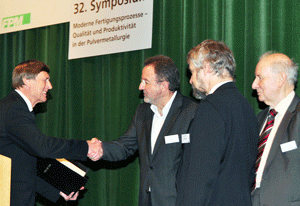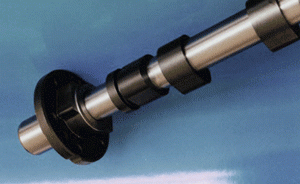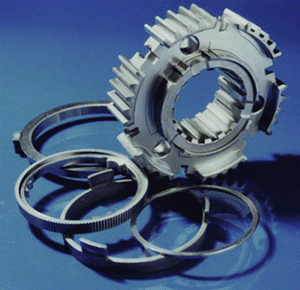2013 Hagen Symposium: Skaupy recipient Josef Seyrkammer recalls Powder Metallurgy milestones during his career at Miba

Fig. 1 Michael Krehl (PMG), Fachverband Chairman,
congratulating Josef Seyrkammer (left) on his
Skaupy prize watched by Herbert Danninger and Hans
Kolaska (courtesy Fachverband)
The Skaupy Prize is the highest honour that the Fachverband Pulvermetallurgie confers to distinguished powder metallurgists. Josef Seyrkammer received this recognition for his life-long dedication to the Powder Metallurgy (PM) industry.
Professor Herbert Danninger, Professor of Chemical Technology, Technical University Vienna, introduced Seyrkammer. Born in Schwanenstadt, Upper Austria, Seyrkammer passed through lower secondary school and went to an engineering school where he obtained his qualification in higher education (Ma-tura). As a hard-working pupil, his teachers recommended him for a polytechnic of mechanical engineering, but his financial resources were limited so instead followed his education in mechanical engineering through evening courses.
In 1965 Seyrkammer joined Miba Sintermetall AG in Laakirchen, Austria, where he soon became head of the tool design department and was later promoted to Business Executive. Having worked in the PM industry for the last 48 years, Seyrkammer has experienced the tremendous development of the industry worldwide, actively contributing to it first-hand. In his Skaupy Lecture Seyrkammer recalled highlights of PM products and processes during his career at the Miba Group.
Early economic boost
Seyrkammer stated that Powder Metallurgy received a first big economic boost with the manufacture of metal spikes for snow tires in the early 1960s. The spikes sleeves were pressed from iron powder on rotary presses with 41 cavities having a capacity of 24,000 parts per hour. Small conical carbide studs were pressed into the sintered spikes sleeves. For corrosion protection the spikes were electroplated with zinc or painted in different colours. During the peak times, Miba produced 300 million spikes per year. However in 1974 spike tires were banned due to the resulting damage caused to roads.
Growth in automotive applications
Seyrkammer explained that the 1970s and 1980s saw a growing penetration of the automotive market with PM components. The level of PM technology was raised step by step to the quality requirements of the automotive industry and subsequently many new applications were developed. Investments in research and development, modern tool making equipment, bigger presses were made and know-how for volume manufacturing was acquired. During this period Miba installed the first in-line press-sinter-size production of timing belt pulleys including a 5000 kN hydraulic powder press, a belt sintering furnace and a 6300 kN sizing press (Fig. 3), stated Seyrkammer.
A further important step forward in the late 1980s were the first PM components with high dynamic load-ing capacity and high density made by Powder Forging (PF), such as truck synchroniser rings. Seyrkammer stated that these comparatively heavy parts were pressed to a green density of 6.9 g/cm³ and sintered at 1200°C. After applying a graphite coating the parts were heated again in a specially developed furnace to 1050°C in endogas and automatically fed to the 10,000 kN forging press.
In the early 1990s the development of sintered cam lobes for assembled camshafts began. The first applications were in engines for low and medium loading with a Hertzian pressure of approximately 600 MPa. The follower components were in most cases barrel tappets with mechanical valve compensation. The cam lobes were made from low alloy steels using the double press and sinter technique. As the load requirements of automotive engines increased to Hertzian pressures of more than 1000 MPa, low alloy steels were no longer sufficient, so cam lobes were made from medium and high alloy steels.
The development work was accompanied by extensive wear testing. The top product of this kind was a precision cam lobe for the assembled camshaft of a 12 cylinder fuel engine (Fig. 4). The follower in this case was a roller towing lever. The outer contour of the cam was concave and in spite of close dimensional tolerance requirements needed no grinding finish, stated Seyrkammer. The cam lobes were double pressed to a density of 7.4 g/cm³ and vacuum sintered at 1200°C.
Bimetallic towing lever
Another highlight of the 1990s was the bimetallic towing lever which combined a sintered steel body with high fatigue strength and a high alloy wear resistant metal surface running against the camshaft (Fig. 5). The tribological properties of the towing lever were excellent and clearly superior to competing technologies like forging and casting, added Seyrkammer. The zone running against the cam was made from molybdenum alloyed steel with a density of 8.3 g/cm³. The parts were pressed in double layer compaction tooling using a specially developed filling system. During sintering at 1300°C an intermetallic phase was developed that was essential for the outstanding wear properties. Finally a surface layer of molybdenum carbide was created in a low pressure carburising process. The area in contact with the valve shaft was induction hardened.
Gearbox applications
A complete synchronising module for the first and second gear of a passenger car manual gearbox consisting of a synchronising hub, two friction rings, synchronising rings, two double cone rings and two fixing rings made from PM steel was developed in the late 1990s (Fig. 6). The parts were assembled and laser welded. Synchronising hub and friction rings were sinter hardened, the synchronising rings were induction hardened in the rooftop areas, the double cone rings were made from hardened steel with subsequent molybdenum coating on both sides. Functional tests of the assembled unit were carried out in-house on a gearbox test bench.
Improvements of existing products and new ones for engine and gearbox applications, power steering, oil pumps and many more followed and were brought to volume production.
In his conclusion, Seyrkammer acknowledged the team of qualified and dedicated staff that has contributed to Miba’s growth over the past 50 years. Today Miba is a widely recognised international group of companies with a high technology standard. Constant changes in the automotive industry pose new challenges on Powder Metallurgy that require the full commitment of all PM engineers.
Author: Dr Georg Schlieper, Gammatec Engineering GmbH, Germany
Dr.-Ing. Georg Schlieper, physicist, received his PhD at the Insitute for Materials and Solid State Research of the University of Karlsruhe, Germany. He worked for 15 years in product and process development for the Powder Metallurgy industry where he focused on high strength sintered steels, heat treatment, surface technology, magnetic materials and metal injection moulding. Since 1994 he has worked independently as a consultant. Email: [email protected]
Download FREE PM Review magazine | News | Articles | Subscribe to e-newsletter










